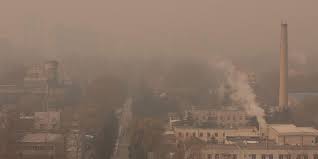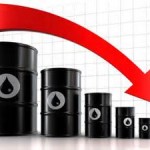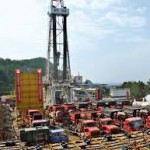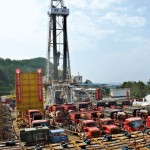
China fights air pollution as winter approaches
Air pollution continues to be a major political issue in China. With the winter heating season starting, the government is pursuing a number of strategies to constrain the level of air pollution in northern China. The twin goals are to keep levels of pollution lower than last winter and to meet targets that were set in 2013.
On 25th October 2017, the authorities issued their first air pollution alert for the Beijing-Tianjin-Hebei area of north China. Highways were closed to traffic in some areas as particulate levels rose. This reinforced the earlier realisation by the government that its efforts to curb air pollution might not meet the agreed targets.
A top political concern
Air pollution has become one of the top political concerns in China because its effect on human health is unquestionable. A recent study by scientists from China, the USA and Israel showed that this pollution affects all ages and reduces life expectancy in China by 3 years. Lung cancer is the most prominent cause of premature death, as the fine particulates become buried deep in the lung. Moreover, scientists have recently discovered a factor that makes north China’s air pollution so dangerous to human health. In 2013, they were puzzled to find significant quantities of sulphates in the air, a phenomenon usually associated with volcanic eruptions rather than photochemical smog. A report of a Chinese study published earlier this year showed that nitrogen oxides were acting as a catalyst for a chemical reaction to turn sulphur dioxide into sulphate. The nitrogen oxides come from vehicle and industrial emissions.
In September 2013, the new government of Xi Jinping set out ambitious targets in its “Action Plan for the Prevention and Control of Pollution”. This document set a number of quantitative targets to be achieved by 2017 and a range of measures to help achieve these goals. The headline targets related to particulate matter. The concentration of PM10 in cities at provincial and prefecture level was to be reduced by 10% over the five years 2012-2017. Certain regions had tougher targets explicitly aimed at PM2.5: a 25% reduction in the Beijing-Tianjin-Hebei region, 20% in the Yangtze River Delta region around Shanghai, and 15% in the Pearl River Mouth Delta region in Guangdong.
Despite sustained efforts by central and local governments, pollution levels rose in the first seven months of 2017 in comparison to the same period the previous year. Last winter, pollution hit record highs forcing local governments to suspend industrial production, close schools and reduce road traffic. In late August 2017, the Ministry of Environmental Protection was obliged to issue a 143-page plan to urgently reduce air emissions across 28 major cities in preparation for the coming winter heating season.
Four strategies
The government has been pursuing four main strategies to address the challenge in advance of the current winter heating season. Whilst none of these strategies is new, they have been pursued with greater vigour over the past year in the Beijing-Tianjin-Hebei region.
The first strategy involves permanently closing the most polluting industrial plants. This approach dates back to the energy efficiency campaign launched in 2004 to combat energy shortages at a time of rapid economic growth. A second long-term strategy has been to force thermal power generators, steel mills and coking plants to constrain their emissions through such measures as flue gas desulpurisation. A third path requires steel, aluminium, plate glass and cement plants to reduce production by up to 50% over the winter period.
The final strategy is to convert industrial plants and household appliances from coal to natural gas. This approach began in the late 1990s when Beijing received its first natural gas from the Ordos basin of north China. However, the rate of take up of natural gas as a heating fuel has always lagged behind government aspirations on account of its high costs compared to coal and the infrastructure requirement
This year, the government has aimed to convert up to four million households to heating systems fuelled by natural gas or electricity. At the same time, some 44,000 coal-fired boilers are to be scrapped and the sale of coal in these towns and villages will be banned. The construction of the necessary pipelines and storage tanks to support this dash for gas at the household level has been an immense task and cost billions of Yuan. It will also add an estimated 10 billion cubic metres to the winter gas consumption. To address the surge in demand, the national oil companies have been instructed to boost supplies, from both domestic and overseas sources. This has had an immediate effect on international markets, with Asian spot LNG prices reaching close to US$ 10 per million British Thermal Units (mmBTU) in early November, up from a low of less than US$6 per mmBTU in June 2017.
Although natural gas is more convenient and cleaner for families, it is more expensive than coal. Northern China is home to large numbers of low income families and the high price of natural gas last winter led many households to reduce their use of heating. Monthly heating bills for some families rose from 1,500 Yuan to 2,000 Yuan despite economising, and the monthly income of many such households may be just 4,000 Yuan. To alleviate such hardship, the government this year is providing a certain quantity of gas at subsidised prices.
Despite the comprehensive nature of the government’s push to reduce air pollution this winter, confidence is low that the targets set in 2013 can be reached. Resistance to implementing these measures is widespread. The most common approach is to falsify emissions reports. In April 2017, a plant in Tianjin took more extreme measures by locking up a team of government inspectors whilst they were carrying out checks on the plant. They had to be rescued by the police. Further, the implementation can be seen by some as being inequitable. In the small towns of Hebei Province, for example, the local steel plant may continue to emit foul effluent while individual food stall owners are told to stop using coal.
Environmental taxes
As part of a wider strategy to combat all forms of pollution, the government will introduce a raft of environmental taxes on 1st January 2018 to replace the generally ineffective levies. These taxes will be directed at air, water, land and noise pollution. The taxes on air pollution will target sulphur and nitrogen oxides, but not carbon dioxide as this is covered by the carbon markets. Small- and medium-sized enterprises will not be exempt, as they were from the pollution levies, but extra incentives will be provided for those which achieve substantial reductions.






